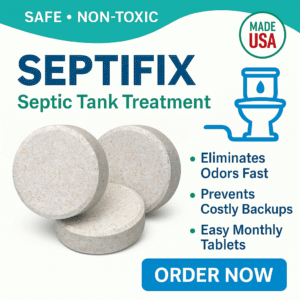Installing a septic tank and leach field is one of the biggest expenses in setting up a property without access to municipal sewer lines. Costs vary widely depending on tank size, soil type, and labor. Understanding the typical price ranges, what influences them, and which products can make the installation more efficient will help you plan ahead and avoid unpleasant financial surprises.
Quick Picks
- Infiltrator Water Technologies Leach Field Chambers – Best Overall: long-lasting, lightweight chambers for effective wastewater distribution.
- Norwesco 1000-Gallon Septic Tank – Best Budget: durable polyethylene tank that fits standard residential needs.
- Concrete Septic Tank with Riser Kit – Best Premium: heavy-duty, permanent solution with easy pumping access.
Buyer’s Guide: What Affects Septic Installation Cost
- Tank Size: Smaller homes may only need 1,000 gallons, while large households require 1,500–2,000 gallons.
- Tank Material: Plastic is lightweight and affordable, concrete is heavy but long-lasting, and fiberglass is mid-range.
- Soil Type: Sandy soils make installation easier, while clay soils or rocky terrain increase labor costs.
- Permits & Inspections: Local codes require permits, which add to the total cost.
- Leach Field Design: Traditional gravel trenches vs. modern chamber systems have different pricing.
- Labor & Equipment: Excavation, hauling, and professional installation are significant cost drivers.
Average Cost Breakdown
- Tank Only: $1,200 – $3,500 depending on size and material.
- Leach Field: $2,000 – $10,000 depending on soil conditions and system design.
- Total Installation: $8,000 – $18,000 for a complete system in most areas.
- Repairs/Replacements: Drainfield repairs can run $4,000 – $12,000 if existing fields fail.
Detailed Product Reviews
Infiltrator Water Technologies Leach Field Chambers
Who it’s for: Homeowners or contractors seeking lightweight, effective alternatives to gravel trenches.
- Key Benefits: Quick to install, durable plastic construction, improves wastewater dispersal.
- Pros: Easier installation; cost-effective; requires less equipment.
- Cons: May not be suitable in areas with strict code requirements.
Verdict: A modern solution that saves on labor and lasts decades.
Norwesco 1000-Gallon Septic Tank
Who it’s for: Smaller households or budget-conscious property owners.
- Key Benefits: Lightweight polyethylene; easy to transport and install; corrosion resistant.
- Pros: Affordable; widely available; durable design.
- Cons: Not as long-lasting as concrete options.
Verdict: A practical and cost-friendly septic tank choice for most homes.
Concrete Septic Tank with Riser Kit
Who it’s for: Homeowners looking for a permanent and robust septic system with easy access.
- Key Benefits: Extremely durable; resistant to floating or shifting; riser provides easy access for pumping.
- Pros: Long lifespan; strong structural integrity.
- Cons: Heavy and more expensive to install.
Verdict: Best long-term investment for durability and low maintenance.
Polylok Septic Tank Riser Kit
Who it’s for: Anyone who wants convenient tank access for inspections and pumping.
- Key Benefits: Heavy-duty polyethylene riser; weather-resistant; simple to install.
- Pros: Saves money on labor; extends tank life; keeps maintenance simple.
- Cons: Adds to upfront installation cost.
Verdict: A smart accessory that pays for itself in reduced service costs.
Zoeller Waste-Mate Sewage Pump
Who it’s for: Homes needing an additional pump system for septic wastewater.
- Key Benefits: Cast iron construction; non-clogging impeller; automatic float switch.
- Pros: Reliable; strong motor; long lifespan.
- Cons: Higher upfront cost and requires professional installation.
Verdict: A heavy-duty pump that ensures smooth septic system performance.
Comparison Table
| Product | Key Features | Best For | Price Link |
|---|---|---|---|
| Infiltrator Leach Chambers | Plastic chambers, easy install | Modern drainfield systems | See Price |
| Norwesco 1000-Gallon Tank | Polyethylene, lightweight | Budget-friendly septic solution | See Price |
| Concrete Tank + Riser | Heavy-duty, long-lasting | Permanent installation | See Price |
| Polylok Riser Kit | Ground-level tank access | Easy inspections and pumping | See Price |
| Zoeller Waste-Mate Pump | ½ HP motor, cast iron body | Heavy-duty septic pumping | See Price |
FAQ
1. What is the average cost to install a septic tank and leach field?
Most homeowners spend between $8,000 and $18,000 for a full installation.
2. What’s the cheapest type of septic tank?
Polyethylene tanks are the least expensive and easiest to install, though they aren’t as durable as concrete.
3. How long does a septic system last?
With proper maintenance, tanks can last 20–40 years, while leach fields often last 20–30 years.
4. Can I install a septic system myself?
DIY installation is not recommended. Septic systems require permits, inspections, and professional installation to meet local codes.
5. How do I reduce future costs?
Install a riser kit for easy access, pump every 3–5 years, and avoid flushing non-biodegradable items.
Conclusion
Installing a septic tank and leach field is a major investment, but with the right products and planning, you can keep costs under control and ensure a reliable system for decades. From modern leach field chambers to durable tanks and riser kits, choosing the right components will save money in the long run. Get your system installed correctly now, and you’ll enjoy peace of mind for years to come.
